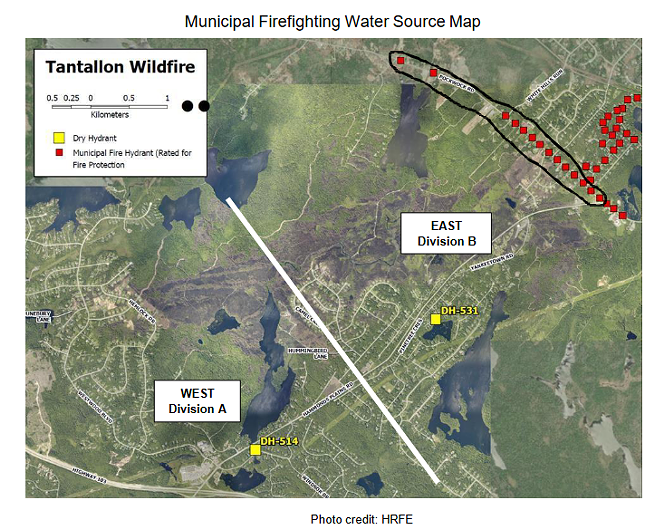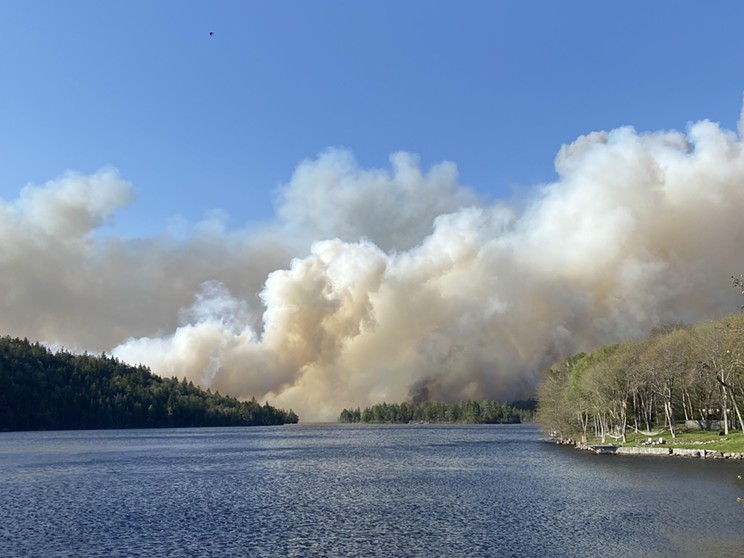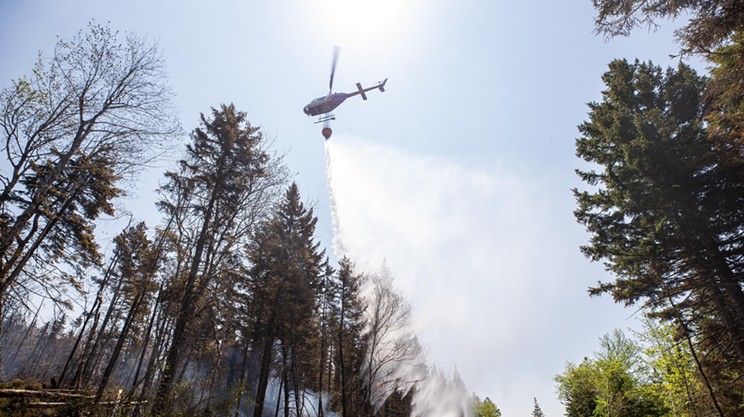Fires need four things to exist, and last year on May 28, 2024, Halifax was a tinderbox waiting to explode. When the temperature gets high and the humidity gets low, it’s easier for fire to stay burning. This condition, known as crossover, is occurring more frequently as the earth’s climate changes. When there hasn’t been a lot of rain or snow over the winter, plantlife becomes a ready supply of tinder. When the province neglects forest management after hurricanes rip through, those downed trees become fuel. Three of the four things—heat, fuel and oxygen—were in abundance; all that was left was what’s known as a sustained chain reaction.
When it comes to forest fires, humans are responsible for starting most of these chain reactions, a whopping 81% of wildfires. It’s little things like flicking cigarette buts or sparks from an ATV, but it’s also the big things, like someone burning in their yard on Juneberry Lane, as filmed by a roofer and reported on CTV.
That backyard burn started to get out of control, and 911 was called at 3:26pm. In a small stroke of luck, Halifax Fire & Emergency engine 65 was ready to go, having just returned from a community event. The firefighters didn’t stop in the driveway of their fire station on Hammonds Plains Road before they raced back out again, lights and sirens on.
A major key to success in fighting a fire is not to let it get too big. To state the obvious, the bigger the fire, the harder it is to put out. The fire department spends a lot of time and money trying to decrease response times. It’s why Halifax is spending money to build a new fire station in Bedford and beef up the staffing for the station in Musquodoboit Harbour. On May 28, with engine 65’s crew already dressed and moving before the call even came in—the truck got to the fire in seven minutes—one minute slower than the HRM’s target of six minutes.
But that was not quick enough.
It took nine days to get the fire under control, and another 15 days to finish up the operation. After every fire, firefighters do a post-incident analysis to see if there are any lessons they can learn from it and if, in the future, they can make their jobs of putting out fires safer or easier. For smaller fires, a small group might talk by the truck before heading back to the station. A fire the size and scale of Upper Tantallon requires more than a quick chat beside a truck, so the department wrote a report and presented it to Halifax Regional Council’s Committee of the Whole this week, at council’s regular meeting on August 20, 2024.
The Canadian dream is designed to burn
It’s very easy to see the appeal of the Canadian exurb, an increasingly popular form of housing that attempts to—and mostly does—combine the main benefits of a suburban home and a cottage. A 20-minute drive to work, nature outside the back door.
But the same thing that makes exurbs so appealing also makes them a fire trap. The long, gently curving roads and low-density designs allow for a lot of wilderness between homes to foster the feeling of being surrounded by nature. Yet that design also makes getting to and containing a fire exceedingly challenging. If a fire starts and spreads to the adjacent wilderness, it is almost impossible to contain. The fire can go from house to house by burning through the wilderness; firefighters must take the roads. This is one of the big reasons HRFE is running a pilot this summer for an early warning fire detection system to get to fires faster. It has also bought trucks that can more easily move through the wilderness.
But there is another big challenge with exurban living, and that’s the Wildland Urban Interface (referred to by the acronym WUI, pronounced “whoo-ee”). Wildland Urban Interface is the technical term for wilderness out the backdoor and the huge wildfire risk that exists when wilderness and human habitation exist close together.
For one thing, HRFE’s firefighters are structural firefighters. Their training is focused on house and building fires; as soon as the fire jumps to the wilderness, even if it’s within the HRM, our fire department doesn’t have the proper firefighting training. Wildfires and building fires require different tactics, gear and equipment, because the things required to fight a short fire inside are different than the things needed to fight a long fire outside.
Halifax Regional Fire & Emergency is trying to mitigate as many of the WUI issues as it can, but most of these things are issues over which the fire department has very little control. The HRFE can’t pass bylaws mandating that new developments are built to Fire Smart standards. They aren’t the ones letting developers build giant, fiscally unsustainable exurbs with inadequate transportation options and no fire hydrants.

Always look for the helpers
Mr. Rogers, that childhood hero of many, said in times of emergency, one should always look for the helpers. It is how we help each other in our times of need that demonstrates the best in humanity. And Nova Scotians are some of the best. But when those wildfires were raging, we were so helpful that we inadvertently caused other issues.
A lot of the outpouring of support for the people fighting the fire came in the form of food donated to the firefighters—so much food that there was no way it could all be eaten. When people from other organizations, like the SPCA, were going in and out of the fire zone to help animals, they needed to be monitored and accounted for so they didn’t get lost and become a new problem. To address the logistical challenges that come with a higher-than-expected level of community support, HRFE plans to hire an additional logistics person.
Things were also made better by the professional helpers. In the report HRFE staff write that the professionals who responded to this extraordinary emergency did so with a level of genuine “effort to do what was perceived as the best course of action without a clear operating policy or procedure to guide such a magnitude incident response. For example, off-duty operational personnel, several in leadership positions, initiated response to the site without formal activation.” But the report also recognizes that this effort and professionalism could be far more efficiently used with better emergency planning. This is a bit nuanced because emergencies for HRFE are also sometimes run-of-the-mill day-to-day operations. This highlighted a need for a strategic plan for when and how to switch from run-of-the-mill emergencies to larger existential emergencies, like out-of-control wildfires.
In his presentation to the Committee of the Whole, fire chief Ken Stuebing stressed that this report was not an audit or an investigation. Stuebing explained that as part of the same professional due diligence that demands a post-incident analysis after every fire, it was in the public interest to do an in-depth investigation and then report the findings to the council and the public.
After a fire as large as Tentallon, which pushed our emergency response to within one errant ember from collapsing, many lessons can be learned. Many of the lessons and changes that stem from this report, like the organizational and planning changes, will be invisible to those outside of the firefighting world. Some of the remedies, like new trucks, fire detection gear and hiring a logistics staffer, will come with a budget ask. What the HRFE needs now is a council to assist them.
The HRFE’s report also clearly shows that, like legislation to regulate development in the WUI, many of the issues the fire department is trying to mitigate are outside their control. For example, the city of Halifax has Municipal Planning Strategies that are supposed to prevent the building of unsafe development. But back in 2022, when a Municipal Planning Strategy should have blocked an exurban Fall River development due to only having one exit, staff instead recommended changing the MPS to allow only one point of egress and removing the requirement for a second exit to the development. Although likely not intentional, if this change goes ahead it will make firefighters’ lives and evacuating Fall River much harder. This debate ultimately led to the province stepping in and designating the land as a special planning area. Special planning areas still need to follow Municipal Planning Strategies; it just means the applications for the areas go to the top of municipal planning staff’s to-do pile. So, there is still hope that the legislative guardrails to prevent this deathtrap design from becoming a reality will remain unamended.
Beyond informing the public, the point of this presentation was to get councillors to think about how the legislation under their purview works for and against the city's plans and goals. The regional planning strategy was put before council on the last day of the wildfire operations in June 2023. Do any of its assumptions of resilient development need to be updated due to HRFE’s findings? Will the new suburban plan, with its deadline of Jan 31, 2025, reflect the lessons of this HRFE report? Since most exurbs are in rural areas, should the rural plan be expedited?
We don’t yet know what the city or councillors will do with this information as they’ve only just received it. There was debate and questions of clarification from councillors after the report, but most of this information was presented to educate councillors, which will hopefully result in better decisions from them in the future when things like dangerous Municipal Planning Strategy amendments to limit egress are suggested. Our councillors and city must learn and adapt fast because we’re heading for a climate-changed future that promises to provide ample opportunities to re-learn hard lessons.


